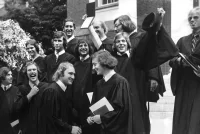
Akira Townes ’17 came to Bates in fall 2013 with plans to go into public health, probably, she thought, as a nurse practitioner. As a student at The Park School in Baltimore, a century-old private K–12 school, she’d done a lot of experiential learning, including three summers of permafrost fieldwork in the Canadian subarctic. She’d even presented that work at a conference in Montreal. She was beyond comfortable in a lab setting.
“I thought I was a scientist,” Townes says, speaking via Zoom from Baltimore, near where she grew up, remembering how ready she felt for Bates and a biology major in 2013. “I was like, ‘I’m going to kill it.’”
Instead, there were biology classes at Bates where she felt like she was “always the dumb one.” In her heart, she knew that wasn’t true, but says there were students and faculty who made her feel that way. She experienced the discomfort of microaggressions. Like, why was it so hard for some professors to tell her apart from the three or four other Black women in her classes, especially the ones she, at five-foot-10, was considerably taller than?
Her lab work still made her feel confident — but her grades on tests reinforced the feeling that she wasn’t cutting it, and there would be material in the class that didn’t translate. She says she has a processing disability but still she couldn’t shake this feeling that “this has zero contextual use in my life. And so therefore, my brain was just like, maybe you don’t need it.”
“I did not fit the mold at the time of what Bates saw as a scientist.”
Akira Townes ’17
Townes did not give up: “I’m first-gen. Quitting was not an option. There was a pride piece in there.” She found helpers, teachers like Paula Schlax (“a godsend of a human”) and Karen Palin, who steered her toward a thesis focused on public health, working with the Community Clinical Services B Street Health Center in Lewiston. Townes still emails and Zooms regularly with Palin.
There were STEM classes where Townes did well, but she left Bates feeling that her faculty did not have solid grounding in “cultural inclusivity or sensitivity,” she says. “I did not fit the mold at the time of what Bates saw as a scientist.”
Historically, the fields of STEM, an acronym referring generally to science, technology, engineering, and mathematics, have had problems achieving equity and inclusion, with science and related disciplines everywhere traditionally favoring white men and excluding women and Black, Indigenous, and People of Color (BIPOC). For Townes, though, this wasn’t something she could just discount as a societal failing. She was going into debt for this education, and she wanted it to be good. And just. “I don’t like injustice,” she says.
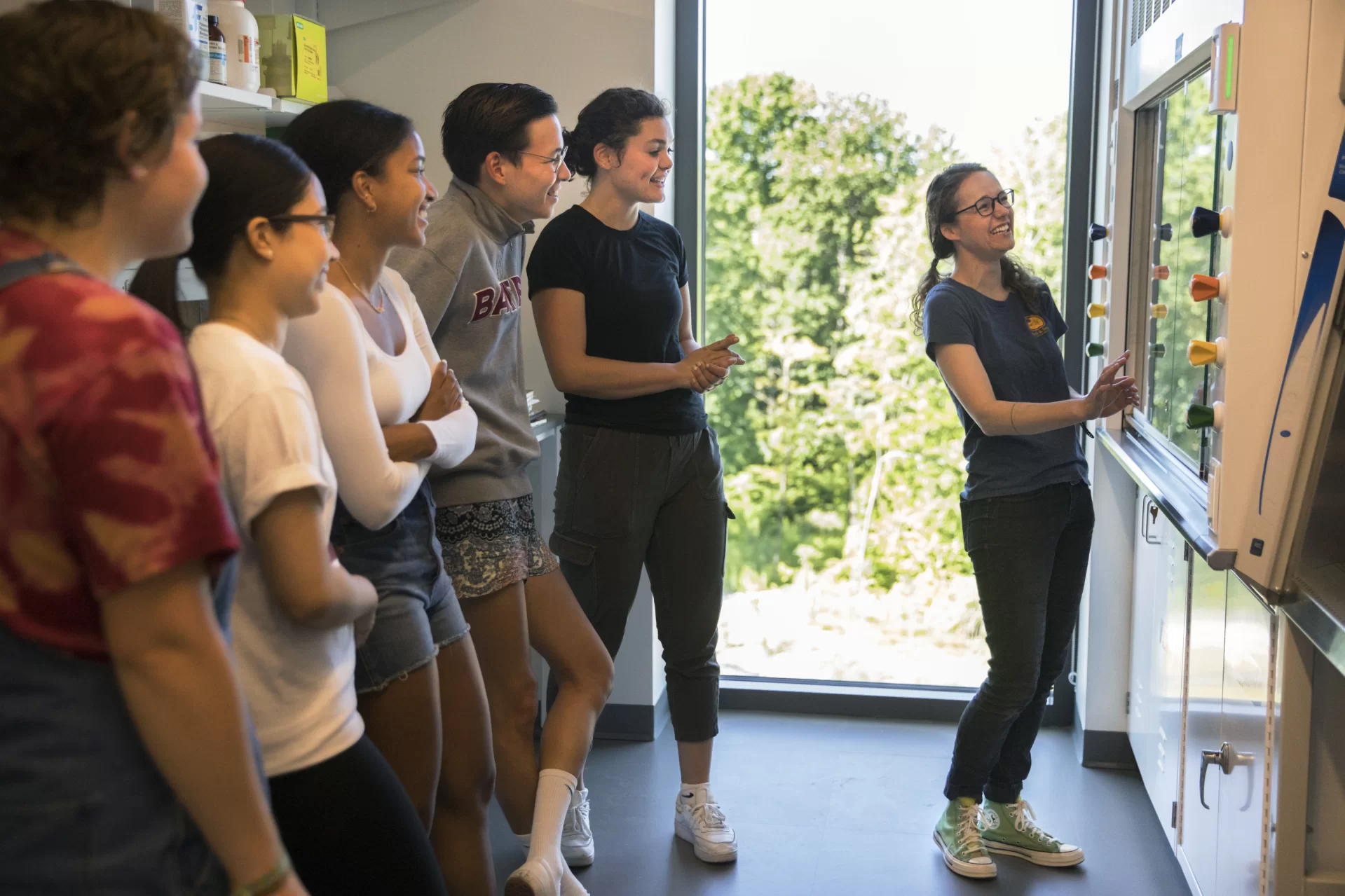
One of her goals in life is “never to leave a place the same way I found it.” With that in mind, shortly before Townes graduated in May 2017, she took action.
In the spring of her senior year, the Bates biology department posted a statement about diversity on its web page — and to Townes, the faculty authors, in their attempt to express solidarity, “fell flat on their faces.” She was particularly offended by what she saw as a contradiction between her experience and what the department said about how it enthusiastically welcomed and valued everyone from all races, nationalities, religions, genders, sexual orientations, abilities, and backgrounds.
So she drafted a letter and circulated it among classmates for input. When she had a final draft, one that was respectful but also direct and damning, she asked for signatures. Some were too worried about their grades to agree. But a dozen put their name to it, albeit in scrawls that were hard to make out.
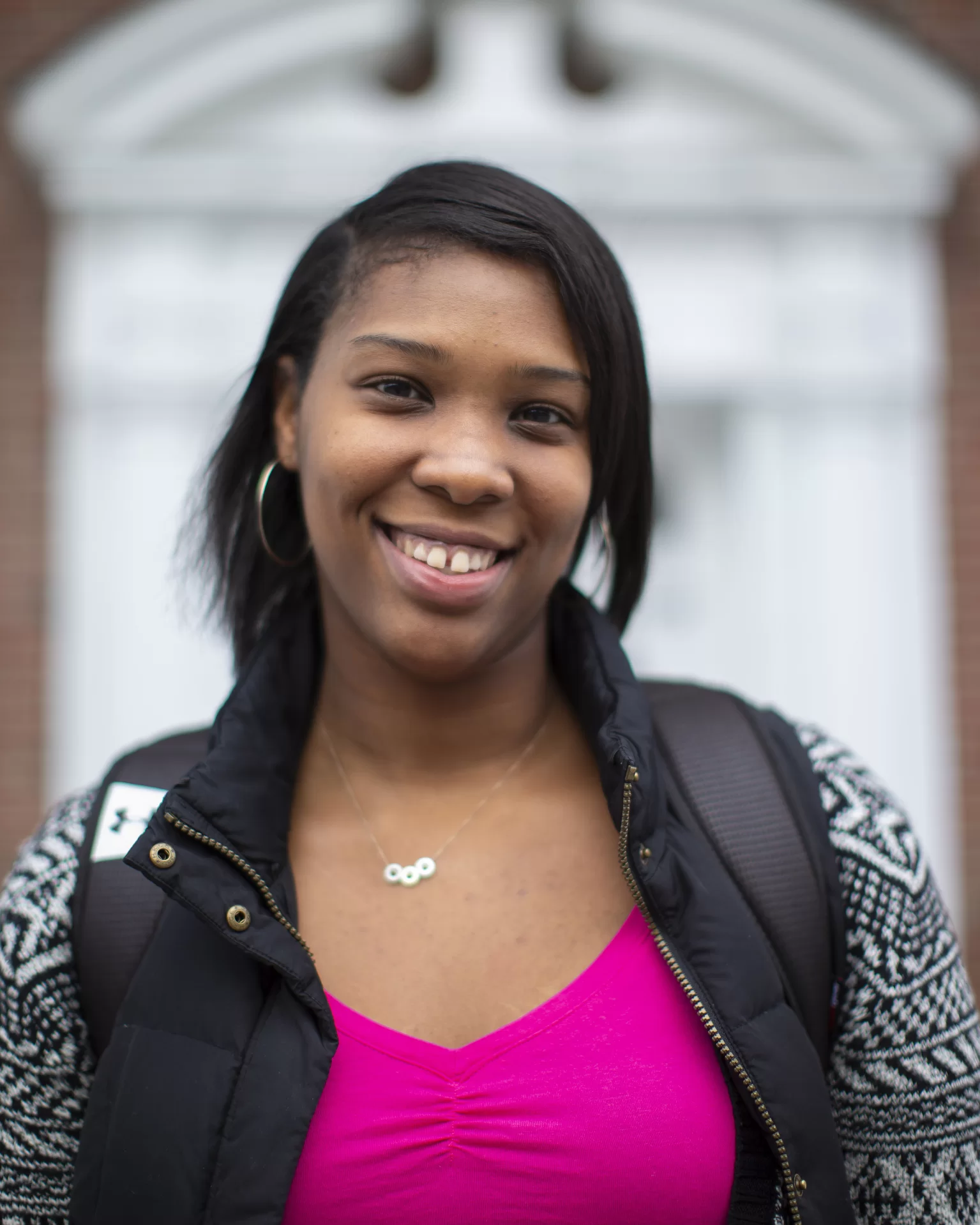
Shown in 2014 while at Bates, biology major Akira Townes ’17 saw and confronted the inequity she and others experienced in their science education. (Phyllis Graber Jensen/Bates College)
Townes slipped into the departmental office and slid copies of the letter into everyone’s mailboxes. Not long after, she graduated and went out into the world. Little could she have predicted its impact on the college she was leaving behind.
Taking initiative
While Townes was at Bates, the college was already beginning to acknowledge, if not yet fix, its approach to achieving greater equity in STEM. The college’s Institutional Plan, which had won approval in fall 2016, put a fine point on the issue, calling for a “comprehensive, multi-year program in the STEM fields designed particularly to support students from underrepresented groups” and asking the faculty to commit to “develop and integrate methods, tools, and approaches that afford all students from all backgrounds opportunities to excel in the sciences.”
With that, President Clayton Spencer and Bates leaders launched the STEM Initiative in 2016–17, its stated mission being that the college “become a model program” that fosters STEM success “through deliberate culture change, including deep research experiences, engaging curricula, inclusive pedagogy, and intentional mentoring.”
Over the last five years, work at Bates to achieve that goal has included everything from curricular changes to new student-support programs, to committed faculty leadership from both longtime professors and new hires. And as called for in the Institutional Plan, Bates has made core STEM facilities improvements meant to address equity and inclusion, both within older buildings like Dana Hall (which has undergone a full gut renovation to focus on science teaching, particularly the introductory courses, and more shared student spaces) and the approach to designing the newest, the Bonney Science Center.
But even as this evolution was beginning, BIPOC and first-generation students were speaking up about the challenges they were facing in STEM majors. In response, the college sought to put a number to what they were hearing. Digging into academic data, the Office of Institutional Research, Analysis, and Planning found that STEM degree attainment for Bates students overall was high, with nearly 60 percent of STEM-interested students graduating with STEM degrees — above national averages.
But looking at the data according to financial capacity, first-gen status, and race/ethnicity, the findings were troubling. Of first-generation students interested in STEM, only 41 percent obtained degrees. For the lowest-income students, only 38 percent received a STEM degree. For Black students, that rate fell to 23 percent.
In 2018 the college’s STEM work received a major boost from a $1 million, multi-year grant from the Howard Hughes Medical Institute Inclusive Excellence Initiative, bringing Bates into a national network of colleges and universities committed to making STEM education more inclusive and equitable.
HHMI grant in hand, Bates deployed one of its biggest efforts, revamping and expanding what was previously a one-year program into a two-year program called STEM Scholars, helping incoming students who are interested in STEM majors begin to think like young scientists, solve problems like young scientists, and, most of all, believe in themselves as young scientists.
“It builds their sense of place and belonging in the sciences,” says Dean of the Faculty Malcolm Hill. “That has been an incredibly important, very student centered, curricular addition at Bates. That’s one of the themes behind all of this; we’re centering the students. And we’re really trying to think about where the structural barriers are.”
As the STEM Scholars become juniors and seniors, they offer support to the new participants in the program. There’s also more encouragement to dive right into research jobs.
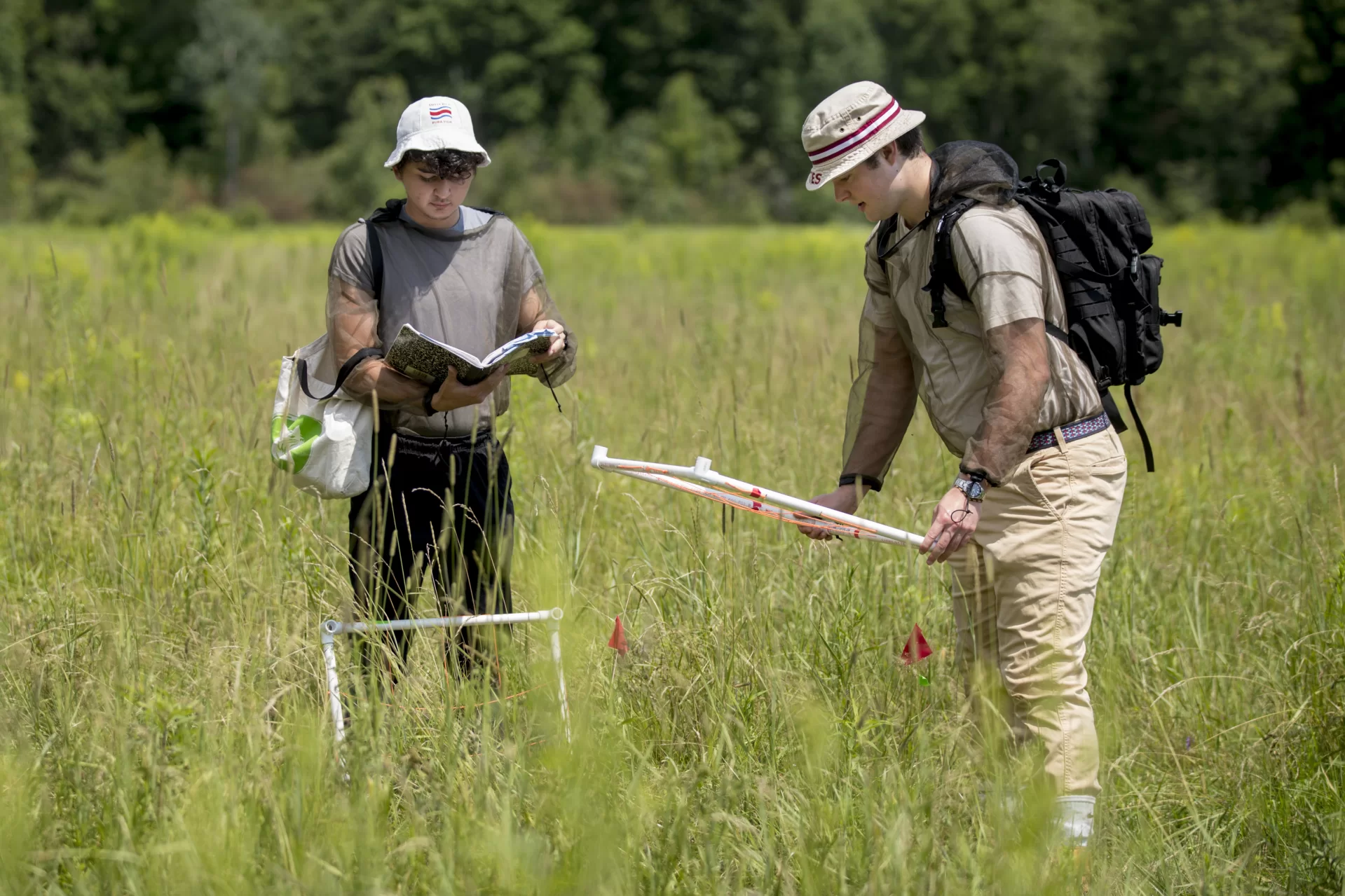
That was how STEM Scholar Sebastian Leon Fallas ’24 of Perez Zeledon, Costa Rica, came to be standing in a meadow at Lewiston’s Thorncrag Nature Sanctuary on a blazing hot day last summer, collecting pollen from native plants while trying very hard not to collect ticks on himself. He and Henry Hardy ’22 of Gloucester, Mass., were both working for Assistant Professor of Biology Carla Essenberg on a research project focused on how much pollen from native plants is available to pollinators.
Hardy and Leon Fallas had protected (or “bagged”) some blooms from bees, butterflies, birds, and so forth, leaving others available for the pollinators. By measuring the amount of pollen in the bagged blooms, the students could calculate how much pollen potential there was in the whole meadow.
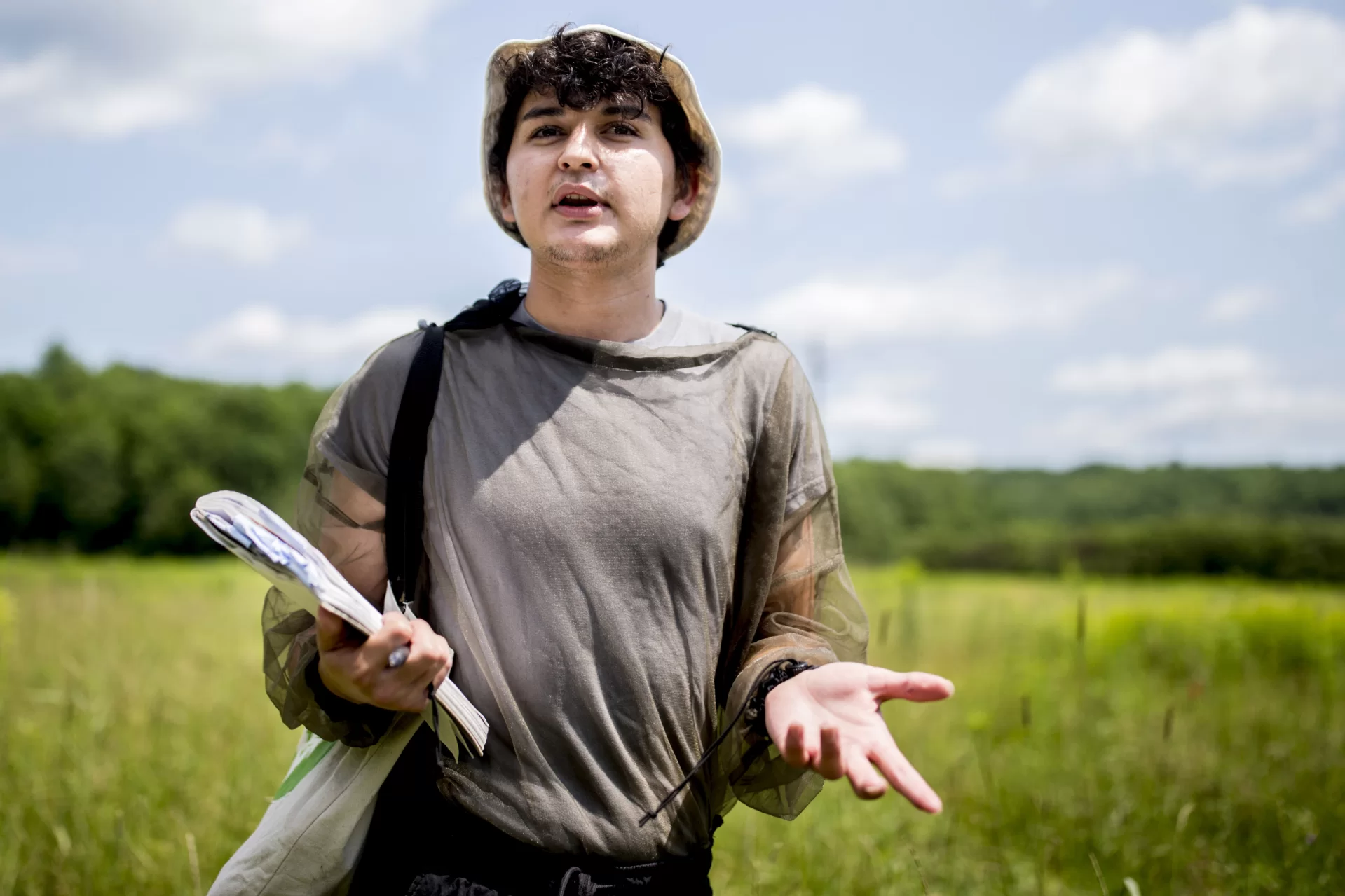
“Doing research during the summer is a way to actually face the real challenges that a scientist has to go through,” Leon Fallas says, “rather than just someone telling you.” Those challenges included identifying species and keeping track of them, collecting and maintaining specimens, then analyzing them. “This is the lesser stitchwort,” Leon Fallas says, pointing to the plant in real life and then as they’d sketched it and other flowering plants in a notebook he carried with him. “Not art majors!” he says, laughing. “But we try.”
Finding a CURE
Another major resource in the STEM evolution at Bates is the leadership of Professor of Biology April Hill, the college’s inaugural Wagener Family Professor for Equity and Inclusion in STEM.
Since she arrived at Bates in 2018 from the University of Richmond, where she had successfully reshaped a curriculum to be more inviting to underserved students, Hill, herself a first-generation college graduate all too familiar with those challenges, has been a force for change at Bates in the STEM disciplines, including department-wide efforts in biology to revamp early courses, what Hill says some would describe as the “gateway” courses, into true scientific inquiries designed to get all students engaged in the material and on equal footing to their peers. With funding from the Howard Hughes Medical Institute grant, Hill and fellow Bates faculty members reimagined these courses, now called CUREs, for Course-based Undergraduate Research Experiences. “These are meant to engage students in the process of science,” Hill says.
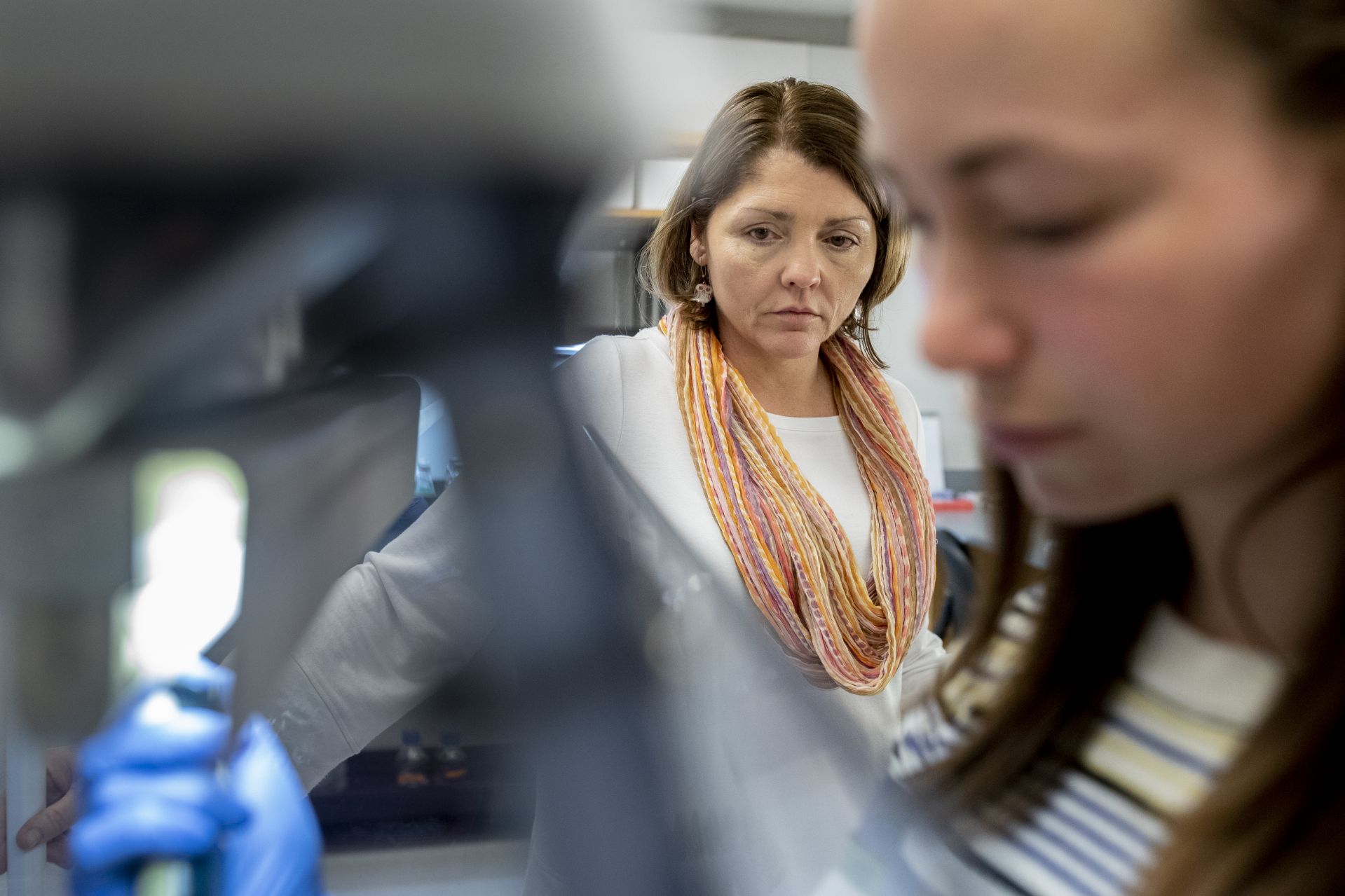
Professor of Biology April Hill, the Wagener Family Professor for Equity and Inclusion in STEM, oversees the work of two students in her Carnegie Science Hall lab in April 2019. She calls the young students “new scientists. For me, it’s like being a coach.” (Phyllis Graber Jensen/Bates College)
Traditionally, introductory courses had been rich on textbooks and labs full of “cookbook” exercises (whereby the student followed a professor’s recipe to a known solution). These gateway courses privileged those who had already taken AP science courses in high school and “weeded out” those who maybe came to subjects cold or felt intimidated or othered by classmates who didn’t want to be their lab partners, or those who just simply didn’t feel supported. People who, if they didn’t understand what was going on in weeks five and six of a course, felt like they’d fallen off a ladder of lessons that stacked one on top of the other and were the only path to the places they wanted to go, like medical school.
People who might have felt, in other words, like Akira Townes sometimes did.
Back when Townes was putting copies of that 2017 letter into those mailboxes in the biology department, there was only one signature that was fairly easy to make out, that of Sophie Wagener ’17, a biology major from Pasadena, Calif. Wagener and Townes had met early on at Bates, became friends, had a falling out, and then, as Townes remembers it, were pushed into working together as lab partners, where the friendship was rebooted into something tighter and lasting. When Sophie’s parents, Deborah Heitz and Shaw Wagener, were considering a gift to Bates, they spoke to President Spencer not just about their daughter’s experiences at the college, but those of her friends. She would drive any gift, they said.
In subsequent discussions with Spencer and other leaders at the college, Sophie was clear: Her friends had aspirations in science and math, but left feeling dispirited. Sophie’s declaration added to the growing mound of evidence that Bates’ STEM curriculum needed work. As Spencer recalled, “Sophie’s experience with her friends was mirrored in our institutional data.”
The ultimate result of these conversations was the Wagener family’s $3 million gift to The Bates Campaign, endowing the professorship Hill holds.
“Sophie watched us in the trenches,” recalls Townes, who, after completing a master’s program in public health at the University of Washington, is now a diversity, equity, and inclusion fellow at her high school alma mater.
“I’m proud of the fact that this was what she and her family decided to do,” Townes says. Without the two friends’ shared experiences in labs, and many meals together in Commons, where white privilege and the Black experience were often discussed, passionately, April Hill might not have come to Bates, where she has been an instrumental leader in the college’s collective and ambitious approach to improving STEM for all.
“You can’t just magically say, ‘Be inclusive.’ It’s not enough to attend training or read a book. People had to practice talking about race and racism together.”
April Hill, the Wagener Family Professor for Equity and Inclusion in STEM
There are already some positive signs based on what Institutional Research, Analysis, and Planning has been able to track. Prior to Bates receiving the HHMI grant, 64 percent of first-generation students took BIO 190 and then subsequently enrolled in a 200-level biology course. After BIO 190 was redesigned to the CURE course 195, that percentage jumped to 94 percent. And the differences in average grades in introductory STEM courses have narrowed considerably across the division.
But as Hill points out, the work is ongoing. “You can’t just magically be like, ‘Be inclusive’” she says. It takes work. It’s not enough to attend a training, or read a book. “People had to practice talking about race and racism together.”
‘Epitome of racism’
Fortunately, that work had already been percolating across departments. Before Aleks Diamond-Stanic, assistant professor of physics, came to Bates he’d been thinking deeply on these issues, prompted by the 2014 police killing of Michael Brown in Ferguson and what it had revealed about racism to him. He read up on the growth mindset in Carol Dweck’s book Mindset: The New Psychology of Success as well as articles and books on how stereotyping impacts humanity.
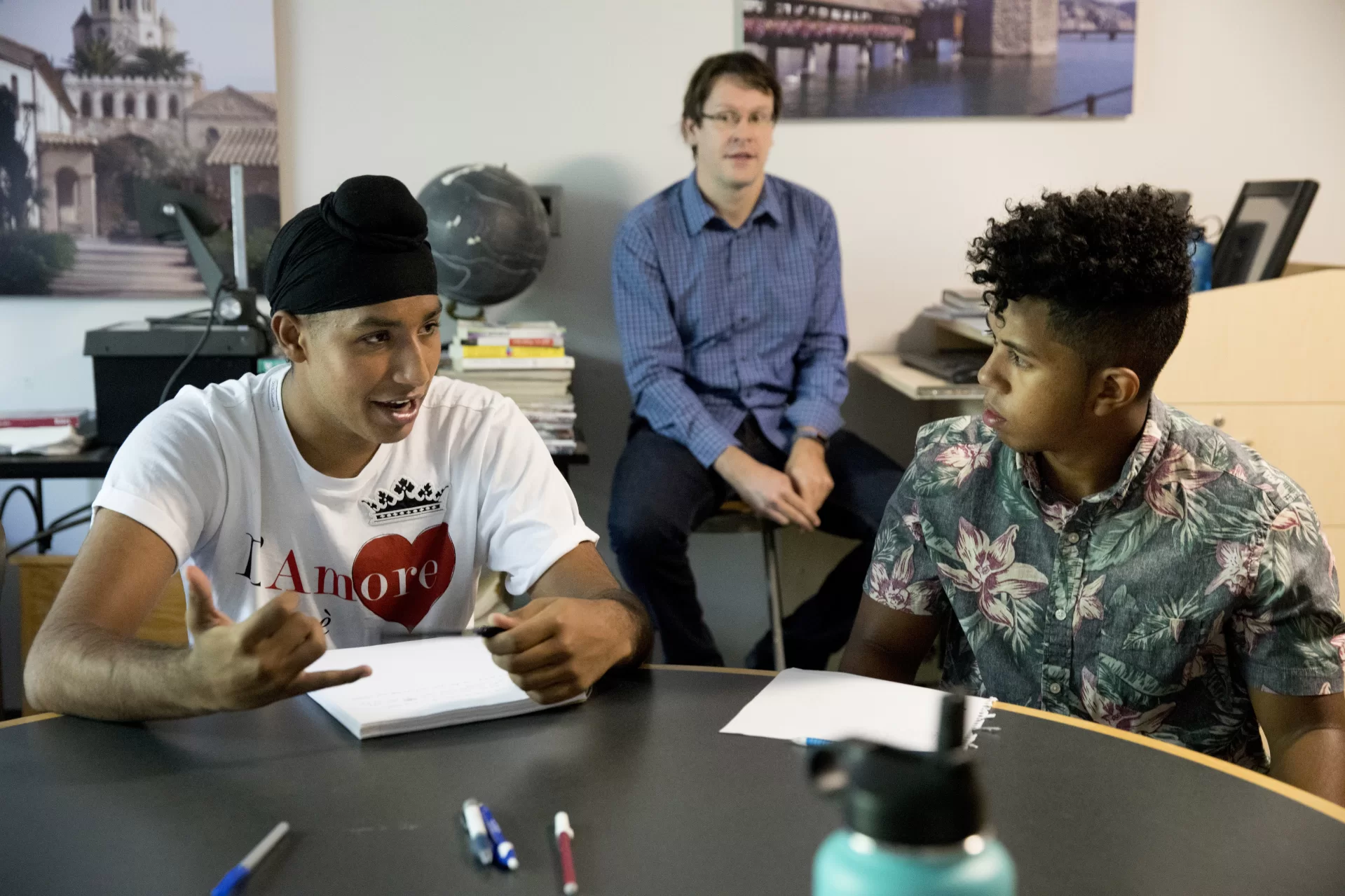
During a class meeting of the First-Year Seminar “Race, Gender, and Identity in STEM” on Aug. 28, 2018, Assistant Professor of Physics Aleks Diamond-Stanic listens as Harkirat Lally ’22 (left) of Yuba City, Calif., and Michael Ratsimbazafy ’22 of Elizabeth, N.J., discuss a prompt. Lally graduated with a biology major; Ratsimbazafy with a anthropology degree. (Phyllis Graber Jensen/Bates College)
Those were helpful, but since then his approach has shifted. As a physicist, he works within one of the most white and cisgender male-dominated STEM fields. “My evolution has been realizing that it’s not just about telling a student to learn the growth mindset and learning how to navigate the system,” says Diamond-Stanic, who was appointed to the Bates faculty in fall 2016. “It’s also trying to change the system in a way that it’s not advantaging and disadvantaging students.”
For many faculty within STEM fields, a visit to Bates by historian Ibram Kendi in October 2017, not long after he’d won the National Book Award for Stamped from the Beginning: The Definitive History of Racist Ideas in America, was particularly revelatory.
My evolution has been realizing it’s not just about telling a student to learn how to navigate the system. It’s also trying to change the system.
Aleks Diamond-Stanic, assistant professor of physics
Associate Professor of Biology Larissa Williams was struck by what she recalls Kendi saying to her after she told him about the data showing racial disparities in STEM outcomes at Bates. He pointed out the baseline of excellence of students at Bates, telling her that her students were some of the best in the country, “all obviously smart.” But, he said, if you can predict how well they are going to do in your curriculum based on skin color, she remembers him telling her “that’s the epitome of racism.”
She was left with the realization that the curriculum was racist. And a desire to change both it and her perspective as the beneficiary of white privilege. Today, “we’re not even close to being done with the work,” Williams says. “But I think that we have done a lot to make sure that we’re supporting all of our students, especially those who have been particularly vulnerable in the past.”
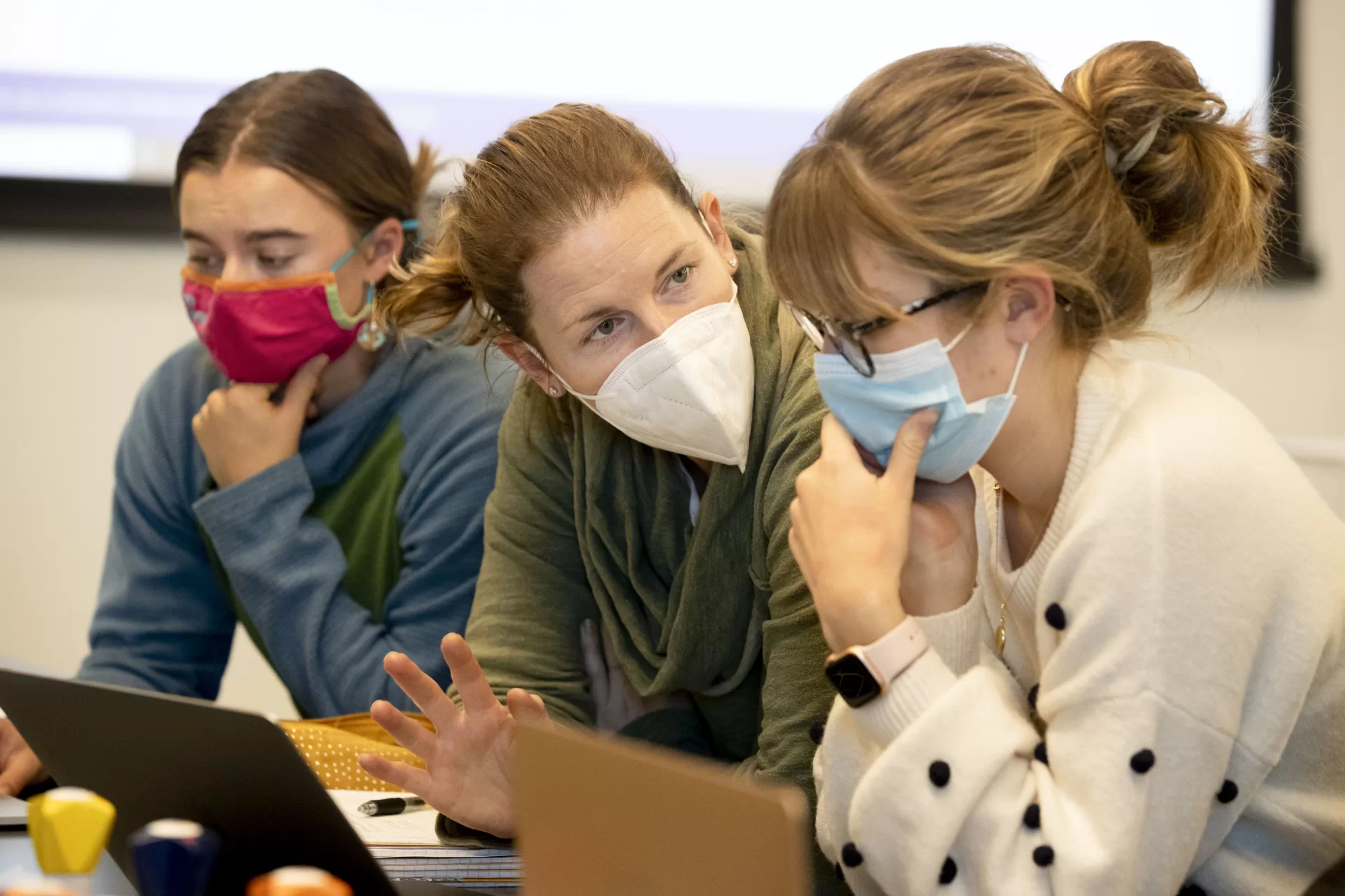
Beyond being a force for curricular change, and an evolutionary geneticist of renown, particularly in the area of sponge research, April Hill has mentored on both a college-wide level in terms of curricular change, and an individual level to STEM Scholars, who sing her praises.
“She has just played such a critical role in my success thus far,” says Jessica Kissi ’23, a double major in biochemistry and French and francophone studies from Chicago. It was at Hill’s suggestion that Kissi started studying French. Her family is originally from Ghana and Togo, and Kissi had been fluent as a child, but lost the language after moving to the U.S. “I just wanted to be able to have a simple conversation with my parents,” Kissi remembers.
It might seem odd that a STEM professor would urge French on her seriously STEM-oriented first-year student with medical school ambitions, but as Kissi tells it, Hill wanted her to diversify her studies as a key component of succeeding. She also asked Kissi not to compare herself to other students.
It worked. Kissi considers this “lifelong advice” to take with her. “Comparisons are the thief of joy,” she says, quoting the adage often attributed to Teddy Roosevelt. After sophomore year, Kissi, again at Hill’s urging, took a summer internship at the Broad Institute (the same Broad that has provided COVID-19 testing for Bates during the pandemic), working on cancer biology. “A summer of expansive research has really opened my eyes to a lot,” Kissi says, including the possibility that she might want to be a physician scientist, getting a dual M.D.–Ph.D. degree.
Kissi is also part of a student-led movement to navigate the sciences collectively. With the encouragement of Assistant Professor of Biology Lori Banks, Kissi started a Bates chapter of a national organization, SACNAS, the Society for Advancement of Chicanos/Hispanics and Native Americans in Science. Then there is Fem STEM, a new club on campus that brings female-identifying students together. They read, listen to podcasts, and discuss shared challenges. “I didn’t know how much I needed it,” says Elizabeth LaCroix ’23, a double major in chemistry and English from Richmond, R.I., who serves as the club’s vice president.
Let curiosity fly
Banks is a relative newcomer to Bates, joining the faculty in 2019. As an undergraduate at Prairie View A&M University, Banks’ campus job was tutoring her peers, some struggling with gateway courses, so she’s particularly mindful of the importance of engaging students. “You have to provide some real-world context to the information and not just, ‘Here is the formula, memorize this list.’”
Banks collaborates with student scientists on work centered on a protein expressed within rotavirus, a highly contagious virus that causes severe gastrointestinal disease and is particularly dangerous to children. Last summer she had five research students working in her lab. “A bit ambitious,” Banks says. “But we all survived.”
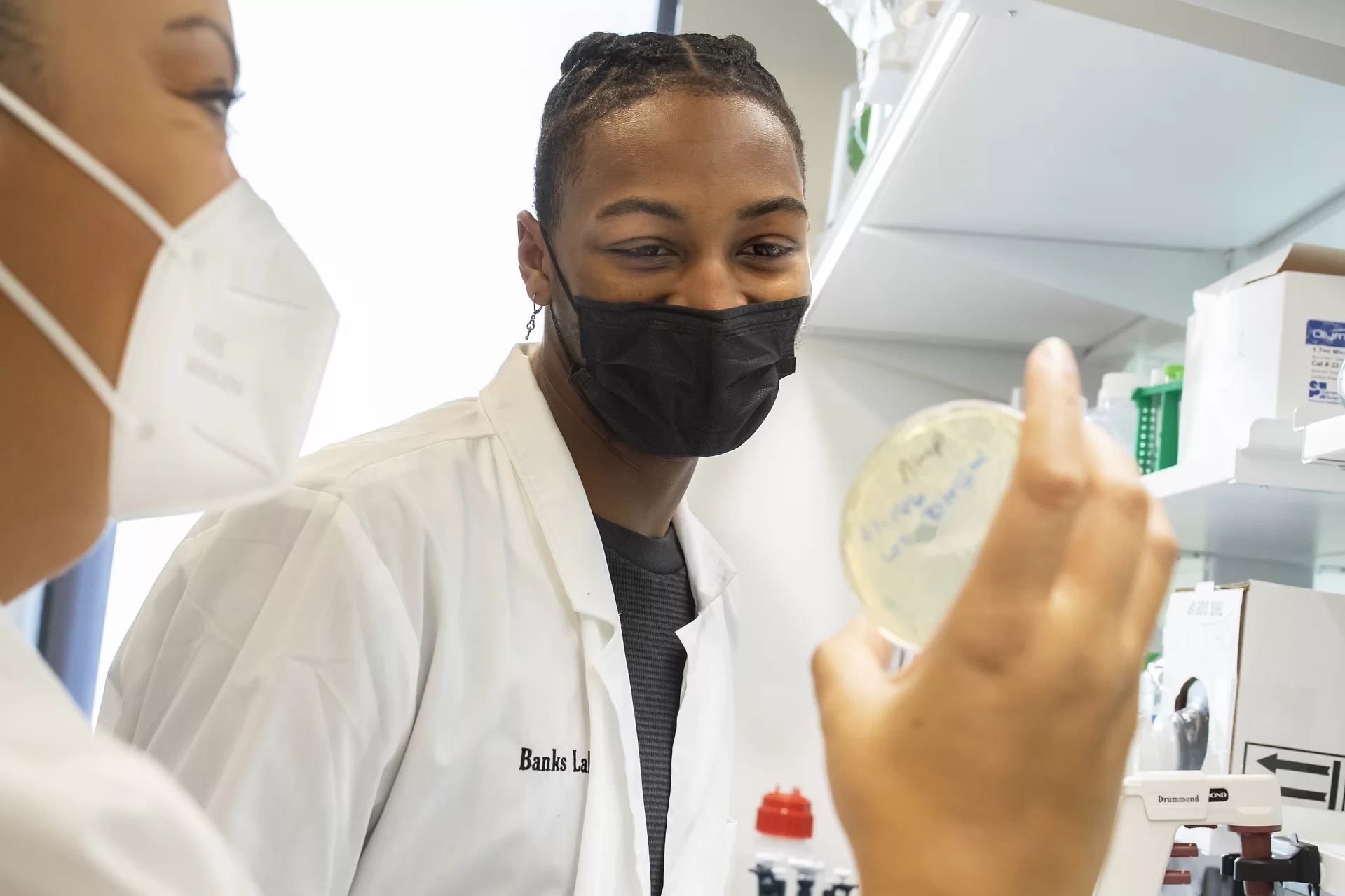
At many colleges and universities, research used to be — and often still is — reserved for the graduate school experience. “Undergraduate students were sort of seen as like, here to take up space, or here just for the exposure,” Banks says. For some Type A science personalities, it is hard to give up control to let undergraduates explore. The faculty at Bates relish it. “You’d be amazed at what students do,” Bank says. “Let their curiosity fly! And you know, if you give them an opportunity? They can make you look really smart.”
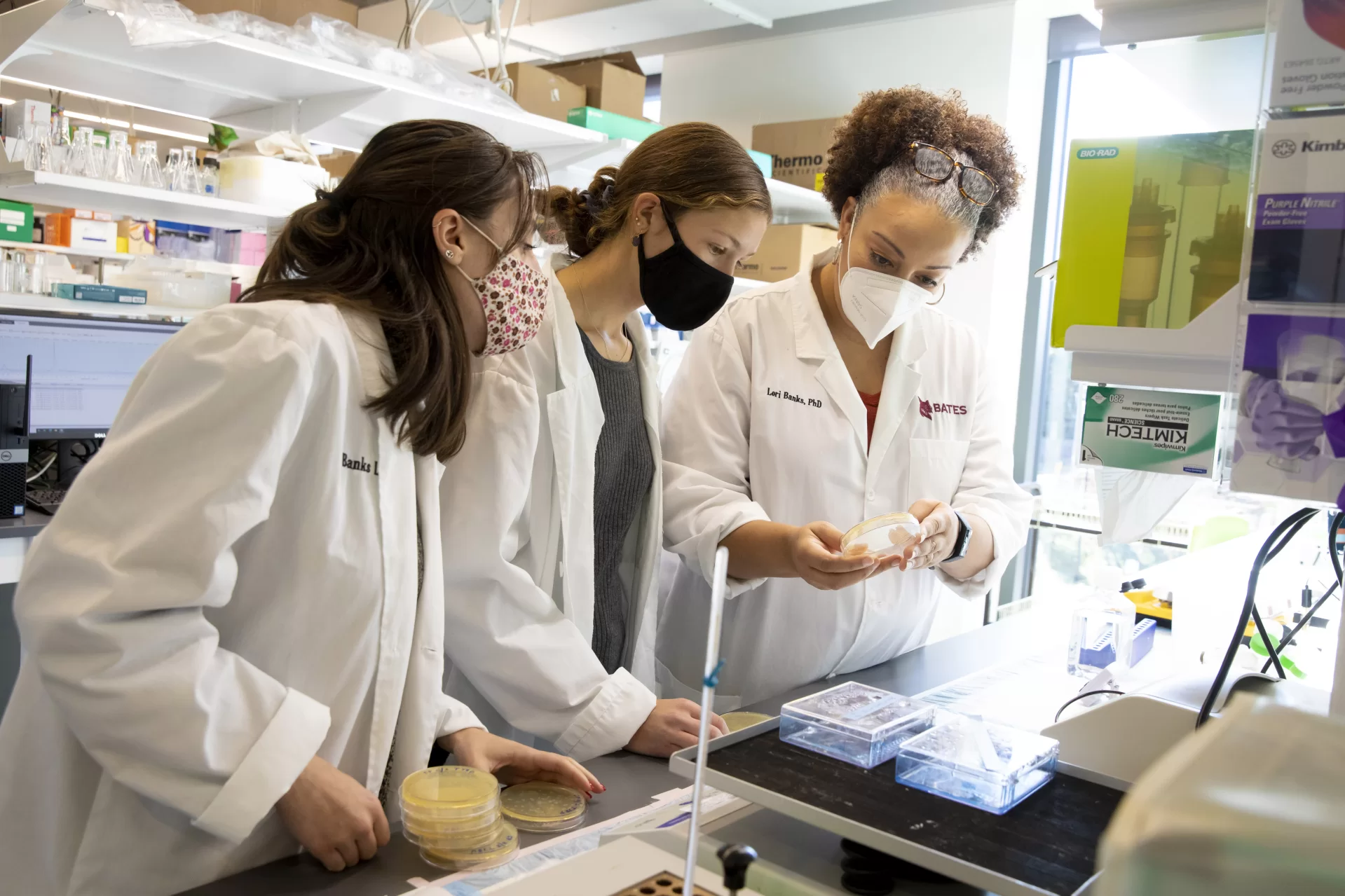
Banks and other faculty moved into the Bonney Center last summer, setting up their laboratories and embracing the way the building’s very design offers a more inclusive experience. Some of the building’s classrooms are used for multiple disciplines, so students who come for a history class might get to see their peers conducting scientific research through glass walls. Within the lab classrooms, there are tables with seating for four.
From Colleen O’Loughlin’s perspective, this is the kind of classroom redesign she would have loved to have during her own education at Ithaca College and Princeton, where the assistant professor of chemistry and biochemistry got her doctorate. “I remember being the only woman in an upper-level chem class,” O’Loughlin says. “And nobody wanted to work with you.”
At Bonney, no one is dragging their desk around the room to form their own groups and, O’Loughlin says, “You’re not asking people to pick groups, right? You just walk in and sit at a table with four people.”
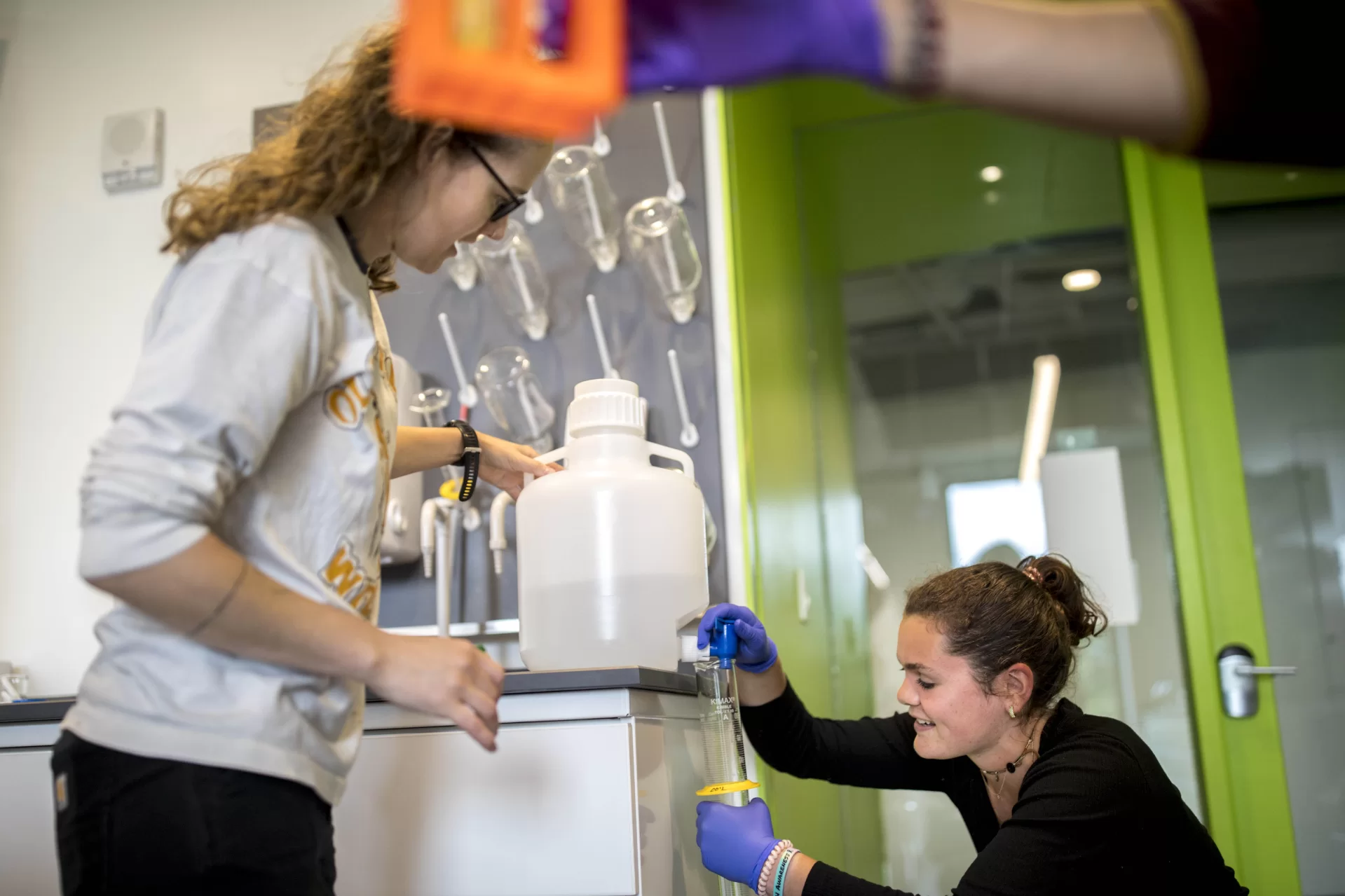
Watching O’Loughlin working with a group of her research students is like seeing the human embodiment of good energy (negative ions, if you will). Clad in a T-shirt, jeans, and green high-tops, she moves around her laboratory with efficiency and enthusiasm, reminding her research assistants that they’ve got a mini-golf outing coming up with her and should wear tie-dye for it. She’s also supportive of all efforts, including mistakes. “It would just be called ‘search’ instead of research if we knew what was going to happen.”
“I remember being the only woman in an upper-level chem class,” O’Loughlin says. “And nobody wanted to work with you.”
Colleen O’Loughlin, assistant professor of chemistry and biochemistry
Raised in a family with eight siblings by a single mother, O’Loughlin was nearly derailed by general chemistry in her first year at Ithaca (“I was not good at math”) and as she entered organic chemistry in her second semester, started planning to find a new major. Then her professor intervened. “He was like, ‘Give me two weeks of organic chemistry. And if after that, this is still how you feel, I will help you get into any class you need for whatever major you want to do. But I think organic’s going to be the thing for you.’ And he was 100 percent correct.”
O’Loughlin pays that pedagogical approach forward. Anna Gouveia ’22, of Jenkintown, Pa., a double major in biochemistry and studio art, has worked closely with O’Loughlin since both arrived at Bates in 2018: “I remember I went to her office hours and I was just like, ‘I feel so lost right now.’” O’Loughlin shared some of her own experiences and that vulnerability both bolstered Gouveia and changed her perspective on learning. “She converted my brain from being like, ‘I’m here for a grade,’ to being like, ‘I’m here to learn this material because it’s interesting and cool.’”
Gouveia works in O’Loughlin’s lab, where she mentors younger students and gets to do more of that cool science, with all its imperfections. “This gel,” Gouveia says, staring down at the slide she’s working with, her expression dubious. “You haven’t seen worse ones, have you?”
O’Loughlin checks out the slide, shrugs her shoulders and agrees. “It’s clearly terrible,” she says, smiling. The whole group of students, including Gouveia, laughs.

